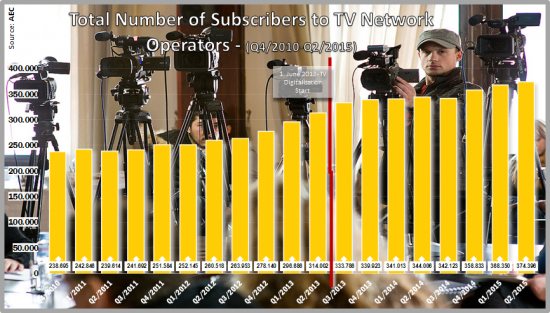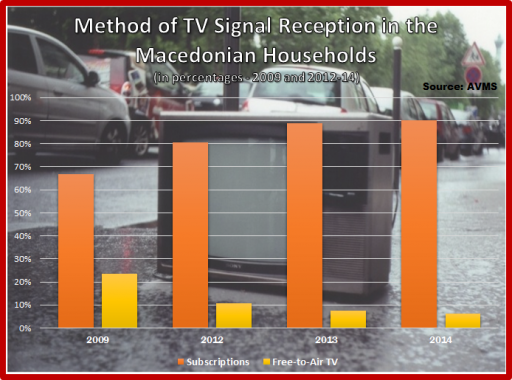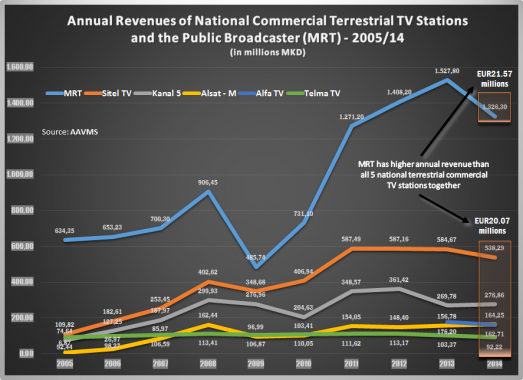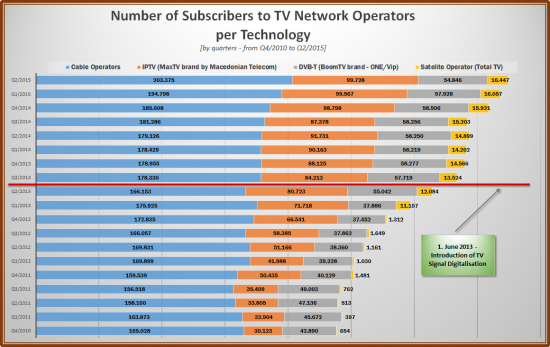Digitalization: Better Image, But No HD Resolution for All
Published in Analyses
on 31 - 03 - 2016 Author: Vladimir Petreski
What did we gain from digitalization of television signal? Do we have television image of better quality? Have new interesting and valuable technologies been introduced? Are there possibilities to have such technologies introduced as result of television signal digitalization?
Written by: Vladimir Petreski
Undoubtedly, digitalization introduced television image of higher quality. Transmission of now outdated composite video-signal, characterized by display resolution of 640×480 (number of pixel lights, i.e. dots on TV screens that change colour and create images) and video-graphic ratio of 4:3 (aspect ratio of display’s width and height) was finally discontinued on 1st June 2013. Resolution, i.e. density of pixel lights, is important because it defines quality of television images – the higher resolution, the better quality and sharpness of images. Quality of television images depends on other elements as well, but this is the most important one and provides basis for improvement of others.
New digital technologies allowed transmission of TV signal in standard definition (SD/EDTV standard of 720х576 pixels) or high definition (HDTV standard of 1280×720 pixels), to maximum resolution of 1920×1080 pixels, thus changing the aspect ratio to 16:9. At the same time, DVB-T standard for programme broadcast was adopted, enabling transmission of TV signal in compressed form.
Today, new and more sophisticated technologies are emerging around the globe, such as, for example, 4K resolution (4096×2160), with certain TV operators and stations from developed countries broadcasting sports events in this resolution for over one year and even longer. In fact, viewing programme in this resolution necessitates specific TV sets, which are still quite expensive. This technology allows viewers to select the camera to their liking for viewing particular moments of football matches, for example. In addition, existing 3D technologies, which allow recording of images with two-lens cameras, require viewers to possess specific so-called OLED TV sets. These technologies are still beyond our reach. First, none of the operators in the country are capable of broadcasting such signal, which means there are no ways for this signal to reach citizens’ TV sets, even if they do possess them. The overall equipment, including video mixers, video converters and cameras used for this type of broadcast are different from equipment currently disposed by the operators and would have to be procured separately. Similar is the situation with the new DVB-T2 standard for programme broadcast, which allows even greater compression of television signal and is more suitable for HDTV transmission, even though the current DVB-T signal can be used for the same purpose. While this new standard, for example, is used for broadcasting 10 SD and HD channels by the public broadcasting service (RTS) in Serbia and by two subscription multiplexes in Croatia, its implementation is Macedonia is nowhere on the horizon.
HDTV IS BROADCASTED, BUT DOES IT REACH TV SETS?
At this moment, we could only strive for and attain HDTV resolution standard of 1920х1080 pixels, as the biggest technology benefit of the digitalization process. Although a handful of television stations, such as TV Sitel, MTV, TV 21, TV Telma, the new cable television – TV Nova, TV Tera from Bitola, etc., already broadcast signal in HD resolution of 1920×1080, it does not necessarily mean that the HD signal actually reaches all TV sets in households across the country. To enable this experience to viewers, TV signals must be transmitted and received in HD resolution throughout the entire broadcasting chain, starting with TV stations, TV operators and ending with TV sets at households. In case only one link in this chain of broadcasting and transmission reduces the quality of resolution, the final signal received will be of lower quality. Such reduction of resolution quality can occur at different points within the broadcasting chain. For example, it can occur at the TV network operator, i.e. operators of public communication networks, which is the official name assigned to commercial companies charging subscription fees to households and companies, such as the cable operators Blizoo, Telekabel, including the operator of DVB-T – One (BoomTV packages), the operator of IPTV – Macedonian Telecom (MaxTV packages) and the satellite operator – TotalTV. Here is what Borce Nikolovski, head of the technology department at TV 24Vesti, said on this matter:
The problem lies in the manner in which operators transmit [programmes] of television stations. Some operators broadcast the programmes of all TV stations on two platforms – HD resolution and SD resolution. Any operator is obliged to have both formats, in order to be able to offer them to end users.
Nevertheless, the problem might occur at the other end of the broadcasting chain, i.e. at households. It would be futile for operators to broadcast signal in HD resolution if subscribers do not have TV sets that allow reception of such image, whereby the signal must be reduced to compatible lower resolution, suitable to TV sets in question, notably by receiver devices (obtained from television operators or purchased at stores for the purpose of viewing free-to-air programmes of national televisions and the Macedonian Radio and Television – MRT) and remote controls.
Around 40% of citizens have not purchased flat screen TV sets and still use CRT TV sets (cathode ray tube), says Nikolovski.
Moreover, not all new flat screen TV sets imply possibility for viewing TV signal in FullHD resolution of 1920×1080, but are rather certified as HD-ready, which means resolution of 1280х720 pixels, for example. In spite of the lack of possibility to reproduce FullHD images, these TV sets are broadly popular due to their affordability (lower price).
Aside from the fact that all TV stations do not broadcast programme in HD resolution, as well as the fact that all households do not have TV sets that support HD resolution, the main question is what happens with TV network operators. More specifically, do these operators – as minimum requirement – transmit HD signal received from TV stations broadcasting programme in this resolution? Here, matters get more complicated and depend on the operator, as well as the type of operator. Cable operators, by rule, should be able to broadcast in HD resolution without any problems, in particular because cables enable unlimited bandwidth and transmission depends solely on equipment at their disposal, and whether their “hubs” are intended for and allow broadcasting in HD resolution. In Macedonia, there are a total of 71 cable operators, majority of which are small and local, thus making it difficult to determine the type of resolution and aspect ratio they are broadcasting.
On the other hand, the satellite operator TotalTV airs programme in HD resolution on the entire territory of the country:
Those [viewers] receiving programme via satellite have a major advantage, notably because they receive good signal on the entire territory of the country. Another advantage is the fact that these viewers can bring their satellite receiver with them and watch TV, for example, at their weekend houses, provided they have adequate antennas in place. They can even take the satellite receivers abroad, because satellite signal is aired in other countries, thus allowing them to view Macedonian channels abroad, says Nikolovski.
In the case of the DVB-T operator, i.e. the operator One and its platform BoomTV, it is still not broadcasting in HD resolution. Even the receivers, obtained as part of subscription to this TV package, do not have so-called HDMI ports, which are indispensable for receiving signal in HD resolution, explains Nikolovski.
BOTH HD RESOLUTION AND SD RESOLUTION FOR THE TIME BEING, BUT ONLY HD RESOLUTION IN IMMEDIATE FUTURE
The situation is slightly more complex in terms of IPTV technology (Internet Protocol), used by Macedonian Telecom to broadcast programme as part of their platform MaxTV.
IPTV can be aired wherever old copper cables are place, in particular through operators’ hubs located in the municipalities, but this broadcast is limited to SD resolution. HD resolution would necessitate installation of optical cables. Hence, this operator receives both SD and HD signals from media outlets, i.e. televisions, in order to transmit HD image to subscribers that have optical cable and relevant HD packages, and to transmit SD image to those receiving signal via copper cables. This [situation] will change in the course of time, and programme will be broadcasted only in HD resolution. The operator is placing new equipment and is setting up new hubs, so ultimately there will be only HD resolution. Subscribers that have optical cable brought to their homes receive FullHD resolution but, at least for the time being, their subscription fees are high, explains Nikolovski.
Otherwise, the number of internet subscribers to the optical cable network operated by Macedonian Telecom, which are able to benefit from the possibility to view TV programme in HD resolution, majority of which actually do because they are subscribed to two- or three-service packages (Internet, TV and landline), accounted for 16,295 in mid-2015, 13,322 of which are households.
Existence of different standards and resolutions in terms of programme broadcasting has taken its tall on televisions as well:
Under current circumstances, televisions suffer damages. They have invested enormous sums of money to be able to broadcast in FullHD resolution, but majority of operators lack technical capacity to transmit FullHD signal to their subscribers, compromising with broadcast in SD resolution. For HD resolution to reach the homes of subscribers, the operator’s network has to have relevant technical possibilities which, as we are witnessing, is not always the case, says Nikolovski.
WHAT IF VIEWERS ARE NOT SUBSCRIBED TO ANY PLATFORM OR PACKAGE
Digitalization had the biggest impact on households that are not subscribed to any commercial television package offered by commercial television operators. Total of 40,000 households, benefiting from social allowance, were awarded receiver devices by the state, while the remaining had to purchase them out of their pocket in order to view TV programme. At the beginning, receiver devices were priced at 1,000 MKD, but nowadays they are available for only 600 MKD and feature an USB port, which means they allow recording of broadcasted programme.
For the purpose of digital signal transmission, the state – through the then current Broadcasting Council (currently the Agency for Audio and Audio-Visual Media Services – AAVMS) – has awarded seven multiplexes (multiplex is a sum of TV services, including transmission of TV signal; the name comes from the word “multiplexing” which means technology for transmission of several signals through one communication channel). Two of them were awarded to the public enterprise “Macedonian Broadcasting” (MB) to transmit MRT programmes, and five multiplexes were awarded to the company One Group, three of which were intended for paid television and two multiplexes for transmission of TV stations at national and regional level. MRT programmes and those broadcasted by national and regional terrestrial commercial televisions can be viewed free-of-charge with the assistance of receivers purchased from stores. But is this the case everywhere across the country? Has the operator One covered the territory of the country with sufficient number of transmitters and has it complied with the initial obligation to cover 92% of the territory, to be claiming that it has attained coverage of 94%?
Questions are raised whether the multiplex operated by One has actually reached coverage of 94 percent. Concerns are raised in terms of this figure’s accuracy. We must see the map of coverage, but ultimately even this map could be unreliable. Establishing the actual situation would necessitate field survey: designation of points and inspection whether they are covered with TV signal and quality thereof. There are always so-called blind spots, i.e. blind zones without signal. At the time of analogue technology, even the slightest repositioning of antennas allowed signal reception, albeit with image noise, but this is no longer the case with the introduction of digital signal – you either receive signal or not, says Nikolovski.
The only solution to this problem is subscription to TV operators with adequate technology possibilities to broadcast the signal everywhere:
There is always a solution. People are already accustomed to these situations and resort to purchase of satellite antennas or subscription to the satellite operator TotalTV. It might even happen for local TV operators to re-transmit TotalTV signal and bring it to inhabitants in particular settlement, he adds.
Contrary to its own TV package labelled as BoomTV, which is not available in HD resolution, the multiplex operated by One, intended for broadcasting commercial terrestrial stations (both national and regional) whose viewing is free-of-charge, and the multiplex operated by MB, intended for broadcasting MRT channels, is broadcasting signal in the resolution of its original airing, which means televisions broadcasting programme in HD resolution can be viewed in HD resolution at households that have HDTV sets and are not subscribed to any package offered by TV network operators.
HOW MANY HOUSEHOLDS ARE NOT SUBSCRIBED TO ANY TV OPERATOR?
How many are these households? Data about this type of households held by different institutions are contradictory and even unavailable. The chart at the beginning of this article concerning the number of subscribers to all commercial television operators shows that 374,000 from the total number of 576,000 households in the state according to 2002 Census are not subscribed to any TV operator. On the other hand, the chart below, published by AAVMS and compiled from survey data, shows that only 6.2% of households are not subscribed to TV packages offered by the operators. This figure is utterly unrealistic. The low share would mean that only 35,700 households are not subscribed to any TV package which, in turn, would imply that several thousands of the total of 40,000 households declared as social allowance beneficiaries, as the grounds for being awarded free-of-charge receivers, have actually subscribed to certain TV package. Moreover, Zoran Trajcevski, PhD, director of AAVMS, in an interview for NovaTV from 31st May 2013, i.e. one day before the start of digitalization, stated that only 15% of households in the country are not subscribed to any TV network operator, accounting for 85,000 households. Difference by 150,000 households, which at that time did not appear in the number of total subscribers according to data disposed by the Agency for Electronic Communications (AEC) and obtained from TV operators, was justified with the fact that the operators had not reported the total number of subscribers for the purpose of tax evasion.
Number of households not subscribed to any operator may range from 50,000 to as many as 200,000 provided that figures submitted to AEC by TV operators are accurate and there is no tax evasion. Most probably, this figure is close to 100,000 households, given that 37,000 households were awarded free-of-charge receivers by the state on the grounds of being qualified as social allowance beneficiaries, and combined with additional 10% of households in the country that are not subscribed to any operator, which is not an overly high number compared to the fact that unemployment rate in Macedonia accounts for around 25%. This would mean that around 100,000 households are viewing only terrestrial commercial televisions with national concession (TV Sitel, TV Kanal 5, TV Telma, TV Alfa and TV Alsat-M) and the public broadcaster (MRT), as well as regional televisions, whose free-to-air broadcast is likely to be discontinued and will be transmitted only through cable operators, as majority of them are not in position to pay 15,000 euros to obtain licenses for being broadcasted on the multiplexes operated by One, as explained by Dejan Georgievski from the Media Development Centre (MDC):
One of the things that happened is the fact that One was practically given monopoly in commercial broadcasting. Now, in order to return money invested in transmission and repetition networks, it has priced national broadcast at 98,000 euros and regional broadcast at 15,000 euros. The idea was for local televisions to transform and become regional, because there is no local frequency. But, what happened in reality? None of the local televisions would be able to afford 15,000 euros. For them, this is an extremely high amount. That is the level to which local broadcasting has stooped. That is why all local televisions have transferred to broadcasting through cable and other operators enabling transmission of television signal.
In that, it should be noted that local broadcasting through cable operators at the level of towns or regions is much cheaper. It is a matter of commercial contract signed between TV operators and TV stations, but there are cases in which cable operators would be willing to locally broadcast a TV station for only 500 euros. On the other hand, this shows that households that are not subscribed to any TV operator, i.e. view only TV stations whose programmes are free-to-air and MRT channels, will not be able to view local TV stations from their town, village or region, unless something changes. In other words, even in this case the cards are stacked in favour of the five terrestrial commercial televisions with national concession and MRT, which are the biggest and the richest televisions on the broadcasting market in Macedonia, where revenue generated by MRTV is higher than the revenue of all five national televisions together.
FOR SUBSCRIBERS, IT SEEMS AS IF DIGITALIZATION DID NOT HAPPEN
It seems as if digitalization did not happen for commercial TV operators. According to official figures, the number of subscribers in the last two years and nine months has increased by only 40,000, i.e. by 12.6%. Small increase in subscription was noted in the second and third quarter of 2013, i.e. in the period when broadcasting of digital signal started, but that was it. This small increase was evenly distributed among all types of operators, except for the DVB-T service operated by One. This TV operator, which also owns the BoomTV brand and does not offer HD resolution, is the only one operator marked by stagnation and even decrease in subscriptions compared to 2013 figures when digitalization was introduced.
Anyhow, the road to implementation of HD resolution is already mapped and one day all TV sets in the country will receive only this type of signal as minimum standard:
One day, we will be told that TV stations are no longer allowed to broadcast in SD resolution, just as AAVMS said that with the start of digitalization SD resolution will be the minimum standard, meaning that TV stations were no longer allowed to broadcast in composite analogue signal, as we used to call it back then, says Nikolovski.
However, when will that happen is still unclear. Certainly, time will have to pass before the current generation of TV sets, which do not support HD resolution but are still being sold, is fully replaced. Until then, new standards will emerge, characterized by higher than HD resolution, of better quality and transmission speed, whereby adoption of new technology would depend on viewers’ interest and excitement with them. Aside from that, the main question is what we have gained from digitalization of television signal, knowing that as many as 55-75% of households had already been subscribed to TV packages offered by commercial operators and it seems that, for this group of viewers, digitalization did not happen. This was best illustrated by Georgievski from MDC:
Digitalization of TV signal has brought image of better quality and less noise in viewing TV programmes. However, we gained nothing in terms of programme offer. In our country, any change, including this regulatory and technology change, does not regulate anything, but further fortifies the existing situation.
(This article was developed in cooperation with the Metamorphosis Foundation, as part of the project “Digitalization in Broadcasting in the Republic of Macedonia”, financed by the Independent Journalism Programs from London.)





